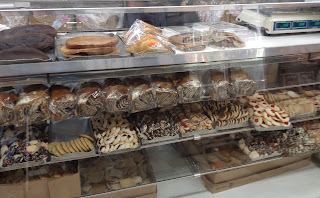On our recent trip to New York, we visited Moishe’s Bakery on the lower East Side and sampled their traditional old-world Rugelach. Inspired by Moishe, this week’s bake are Crescent-Shaped Rugelach from America’s Test Kitchen.
Part cookie, part pastry, Rugelach are a traditional Jewish party snack. The dough is made with tangy cream cheese and sour cream and is tender and flaky; the filling has a combination of apricot preserves, raisins, and walnuts.
Rugelach” is a Yiddish word that literally means “little twist.”
Rugelach originated in the Jewish communities of Poland. It is popular in Israel, commonly found in most cafes and bakeries. It is also a popular treat among Jews in the diaspora.
Traditional rugelach are made in the form of a crescent by rolling a triangle of dough around a filling. Some sources state that the rugelach and the French croissant share a common Viennese ancestor, crescent-shaped pastries commemorating the lifting of the Turkish siege, possibly a reference to the Battle of Vienna in 1683. This appears to be an urban legend however, as both the rugelach and its supposed ancestor, the Kipferl, pre-date the Early Modern era, while the croissant in its modern form did not originate earlier than the 19th century. This leads many to believe that the croissant is simply a descendant of one of these two.
Here is the recipe:
Crescent-Shaped Rugelach from America’s Test Kitchen.
INGREDIENTS:
Dough:
2 ¼ cups unbleached all-purpose flour
1 ½ tablespoons granulated sugar
¼ teaspoon table salt
½ pound unsalted butter (2 sticks), chilled and cut into 1/4-inch pieces
8 ounces cream cheese, cut into 1/2-inch chunks and chilled
2 tablespoons sour cream
Fruit Filling:
2/3 cup apricot preserves
1 cup (7 ounces) granulated sugar
1 tablespoon ground cinnamon
1 cup golden raisins
2 cups walnuts, chopped fine
Glaze:
2 large egg yolks
2 tablespoons milk
BEFORE YOU BEGIN
Be sure to stop processing the dough when the mixture resembles moist crumbs. If the dough gathers into a cohesive mass around the blade of the food processor, you've over-processed it. If at any point during the cutting and rolling of the crescents the sheet of dough softens and becomes hard to roll, slide it onto a baking sheet and freeze it until it is firm enough to handle.
INSTRUCTIONS:
FOR THE DOUGH:
Pulse flour, sugar, and salt in food processor until combined, about 3 pulses. Add butter, cream cheese, and sour cream; pulse until dough comes together in small, uneven pebbles the size of cottage cheese curds, about 16 pulses. Transfer dough to counter, press into 9 by 6-inch log, and divide log into 4 equal pieces. Form each piece into 4½-inch disk. Place each disk between 2 sheets of plastic wrap and roll into 8½-inch circle. Stack dough circles, between parchment, on plate; freeze for 30 minutes.
FOR THE FILLING: Meanwhile, process apricot preserves in food processor until smooth, about 10 seconds. Combine sugar and cinnamon in small bowl; set aside. Line 2 rimmed baking sheets with parchment paper. Working with 1 dough circle at a time, remove dough from freezer and spread with 2½ tablespoons preserves. Sprinkle 2 tablespoons cinnamon sugar, ¼ cup raisins, and ½ cup walnuts over preserves and pat down gently with your fingers. Cut circle into 8 wedges. Roll each wedge into crescent shape; space crescents 2 inches apart on prepared sheets. Freeze crescents on sheets for 15 minutes.
FOR THE GLAZE: Adjust oven racks to upper middle and lower-middle positions and heat oven to 375 degrees. Whisk egg yolks and milk in bowl. Brush crescents with glaze. Bake until rugelach are pale golden and slightly puffy, 21 to 23 minutes, switching and rotating sheets halfway through baking. Sprinkle each cookie with scant teaspoon cinnamon sugar. Transfer rugelach to wire rack with metal spatula. Let rugelach cool completely before serving. (Rugelach can be stored at room temperature for up to 4 days.)
Here are some pictures from the bake:
Have a great day !





Comments
Post a Comment